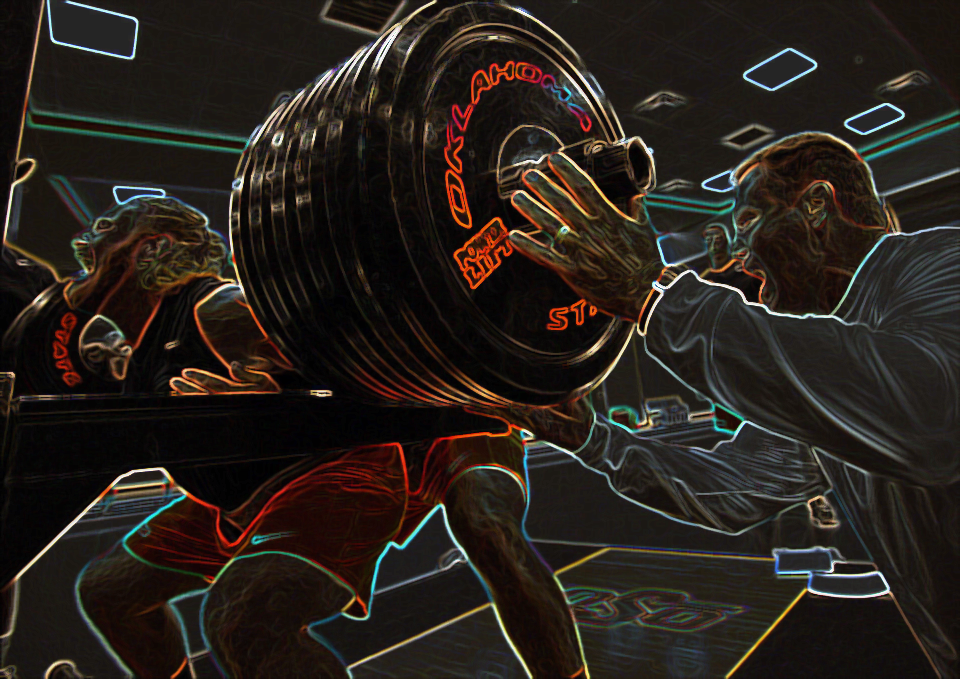
Strength vs Speed
The legendary Mike Boyle liked my summer article, Ten Sprint Facts I Wish Everyone Understood. Mike encouraged Anthony Renna to interview me on a podcast and got me signed up for his website. Mike posted my article and the forum lit up. The back and forth was fascinating. Mike Boyle did a great job of tamping down the anger coming from the forum members. You must remember, the S&C world grew out of body-builders and power-lifters of the 1970’s and 1980’s which corresponded with the beginning of the steroid era. When a high school track coach assaults weight room disciples with heretical venom questioning their very existence, the testosterone levels, already high, may zoom to alarming levels.
“Weight lifting does not improve speed. Lifting weights will improve strength. That strength may transfer to athleticism but won’t directly improve speed. The strongest kids on the team are seldom the fastest. The typical weight room celebrates indiscriminate hypertrophy (bodybuilding). In my opinion, kids who lift weights get better at lifting weights. Beware of muscle-bound poster boys who live in a weight room. Strength coaches will tell you that great teams are made in the weight room, but remember, when you ask a barber if you need a haircut, he will always say yes. “ – Tony Holler, from Ten Sprint Facts I Wish Everyone Understood
The picture I used to illustrate my point poured salt on the wounds. Yes, I went rabbit hunting with a buffalo gun here, but my father-in-law taught me, “If you’re gonna be bear, be a grizzly.”
But that guy is a body builder! We do “functional training”!
Yes, yes, yes. Every training facility does functional training with modalities coming from Charlie Francis, Mike Boyle, Boyd Epley, Stuart McMillan, Dan Pfaff, Barry Ross, Jimmy Radcliffe, blah blah blah. (By the way, when someone drops words like modalities, I immediately think Echo Chamber of the Experts.) Here’s the problem: if your weight room takes pictures of muscle-bound teenagers draped in chains and you tweet those pictures to your meathead followers, you are promoting bodybuilding. Most young athletes lift weights to get big and get girls.
Healthy Debate

The following was taken from the Michael Boyle Forum from StrengthCoach.com. The statements from others on the forum are in red, my responses are in black.
“Strength training is key to injury prevention.” Maybe in contact sports, yes, lifting prevents injury (Mike Boyle call this “collision survival”). In terms of soft-tissue injury, I believe weight training causes more problems than it prevents. Notice I said weight training. Strength training and weight training are not one and the same. Yes, there’s overlap but I can make the argument that “strength training” is much healthier for sprinters than “weight training”. Depth jumps and squats build different types of strength. One improves sprinting, one doesn’t.
“If strength is a factor in acceleration, and lifting weights improves strength, wouldn’t it mean that lifting weights would improve the acceleration component” Strength is a component of acceleration. Strength is a product of weight room. However, weight room strength is not the only source of strength. Here’s something I’ve found: Sprinters who are really fast (max speed) are really good accelerators. When max speed improves, acceleration improves. This leads me to the conclusion that sprinters are strong because sprinting is an under-rated strength exercise.
“Specific weight lifting designed to increase a sprinter’s ability to produce force will increase speed.” This statement is hard to argue with but argue I must. Speed is neurological, not muscular. Those weight room people who believe in the existence of specific weight lifting which will increase speed also believe speed can be improved without sprinting. Nothing in the weight room directly corresponds to an increase in speed. Some things in the weight room directly correspond to a decrease in speed. My definition of speed is max speed, not a 10 yard acceleration. And, before you say acceleration is all that’s needed in football, why do they test the 40 instead of the 10? Max speed is the Holy Grail of athleticism.
“Does this mean you believe that lifting in concert with sprinting is more advantageous for your football players from a speed/acceleration standpoint than either one by itself?” Yes! As long as guys aren’t achieving massive hypertrophy, weight lifting and sprinting can coexist and maximize each other. Football players must sprint and lift. As a high school track coaches, our two biggest enemies are personal trainers and overzealous football coaches. Both preach strength in the absence of sprinting. Both glamorize “getting big”. Both give athletes a chance to live in the comfort of hard work without competition. Both perpetuate specialization.
“I’ll side with Charlie Francis (and his ideas on weight training).” I’ll side with Dianabol, Testosterone, Furazabol, Turinabol, and Winstrol. And, yes, steroids work incredibly well for sprinters. I work with high school athletes.
“My consensus is that individuals that excel at sprinting are a genetic anomaly to begin with. Not to take away credit for the hard work they put it, but they were born with potential that the rest of us were not.” This is the quintessential belief of every hard-working Caucasian weight lifter in the world. I train speed and speed is a skill. All skills are inherited. Lack of skill is inherited too. All skills can be improved, even elite skills.
“What would you consider ‘core work’?” (asked in regards to my statement that my guys don’t do conventional core work) I consider “core work” anything that is core-focused like crunches and planks. If you ask a generic personal trainer about core work, seems like they always want to get down on the floor. We do specific sprint drills to work on lateral chain which is core related. We sometimes do core work where the core is stable as the arms and legs move, this replicates sprinting. Nothing is done laying on the floor replicates sprinting. By they way, all my sprinters look like they do core work every day.
“Do you think strength training could help a sprinter get out of the blocks quicker?” Yes, strength helps us push and drive. However, I’ve found that as max speed improves (10m fly), so does the 30m block start and the 40y dash. I also believe that acceleration improves strength in a perfectly specific way. I’m a speed guy not a strength guy. We never push or pull anything. You will never see us running with a parachute. We always run with the wind.
The Olympic training camps in Germany all use strength training for sprinters. Although they are not a successful as in the former DDR (East Germany), they still use training formats that are used all over Europe. In most cases, the sprinter with more horsepower (just look at their build) are often faster than their leaner opponents. There’s no such thing as a “correct strength training program”. It’s all based on hunches and copycat programs. The fact that some sprinters are powerful-looking does not mean they got that way in the weight room. I call it natural strength vs artificial strength. Natural strength is more functional. Every elite sprinter I know was a sprint phenom when he was young. The weight room has never built a sprinter, ever. Ben Johnson is a possible exception but we all know the flip side of that coin. Increased size just doesn’t translate to more speed. It usually has a reverse effect. Every NFL player would be faster if they lost weight. I encourage lots of sprinting, tons of rest, as much sunshine as possible, limited strength training, and acceptance of body weight. If you were a sprint coach, I think you’d change your priorities. I see more thin sprinters than thick ones. My 14 year old sprinter is 5’6″ 147 pounds. Marcellus would have placed 3rd in the Big Ten this year (10.40). He lifts upper body, no lower body during the track season. I will forever shout this from the rooftops: SPEED IS NEURO, NOT MUSCULAR.
What’s your advise to coaches like us who train team sport athletes that need both strength and speed, and lift weights multiple times per week? Based off the fact the athletes are going to lift weights, would you change anything about the way you would train them for speed? Train for speed when the nervous system is fresh. Me and our football coach have a good relationship. Football players are going to lift, and “bigger” will always be their goal. All I do is encourage him not to get into bench/squat ruts, don’t chase numbers every day, be as random as possible, and don’t mess up my Mon-Tues-Wed speed sessions. He’s come a long way. Even simpler, never let today’s workout interfere with tomorrow’s workout. Our football coach knows that he can’t have a crushing leg workout until Thursday (we take Friday-Saturday-Sunday off during our winter training). Most of my sprinters refuse to do squats during the spring because they know they will have a 48 hour hangover and their speed times will suffer. I posted this earlier but here goes again, Record, Rank, and Publish. And, here is an article I wrote before our football team played for the state championship last year (we got beat by nationally-ranked East St. Louis 26-13), Speed Kills, the Sequel.
Are there other successful sprint coaches out there that “do” incorporate strength training? I may be wrong but isn’t one of “Parisi” speed schools indicators of speed how many chin ups someone can do? Does the highest vertical jump indicate the fastest athletes? Doesn’t proper strength training increase vertical jump? I love chin ups and all kinds of pulls. I love climbing rope. We do lots of auxiliary stuff (we call it x-factor). Yes, vertical jump is directly related to speed, and importantly, speed is directly related to vertical jump (A–>B and B–>A). My question to you, what is the best way to improve vertical jump? I have my ideas. I hear too many meatheads talking about “strength training” getting kids fast in the absence of sprinting. On this subject, I’m 100% certain these guys are wrong. I’ve never discouraged a sprinter from lifting weights, ever. However, because I time my sprinters on a regular basis, they begin to learn what works and what doesn’t. None of my sprinters are fans of squatting.
Our strength training is not the typical high school program of ugly lifts and wasted time. We are very specific. For track people our workouts are probably more Frans Bosch type (although most of the time I don’t understand but, look at the pictures). We are very unilateral. (from Mike Boyle) Unilateral is good. Sprinting is a one-legged sport. If it improves the vertical jump, I endorse it. If it ruins tomorrow’s workout, I don’t. We only sprint two or three times a week, so respecting sprint days shouldn’t be a problem.
I would put the clocking idea in line with competitive drills. Best way to get someone to sprint harder is to make them run against someone. I think the concept of shortening the distance for safety is the right move. Coming back to the timing, at SC working under Aaron Ausmus who has a track background, we were hand and electronic timing 2-3x per year 40s. One of the biggest realizations was all improvements were coming in the first 20. We made the jump to only testing 20s from the perspective all improvement were coming there and it was just flat out safer. As well, making all sprints outside of timed trials as competitive as possible. One of the big things in timing, is the constant “what I get”, which personally I thought was incredibly annoying when you got 100 kids to get through. Not to mention, you put a clock on something, much like anything testing it can sloppy rather quickly. I think the bottom line is that sprinting to get faster is maximal effort. We are from different planets, and that’s OK. “Clocking idea in line with competitive drills?” Huh? The clocking idea measures speed. Speed is the #1 quality of athleticism! We improve what we measure. Sprinting potentiates everything! Sprinters get better at jumping, quickness, and all things neuro. There is NOTHING more neuro than sprinting. Timing 40’s three times a year? Holy cow! How can you improve a skill practiced three times a year? No wonder your biggest improvements were coming in the first 20 yards of the 40. You were neglecting the 10m fly (max speed). In my experience of quantifying speed over 10,000 times a year since 1999, I have found the 10m fly to be the Holy Grail. The faster your max speed, the better you accelerate, the quicker you are, the higher you jump. My program is nearly injury-free. We time over 300 40s every Monday and Wednesday all winter. We sprint three times a week (measured) for our entire 19-week track season. Sprinting is a skill. If you lift all the time and measure speed 2-3 times a year, yes, injuries will happen. My program also uses RPR (Reflexive Performance Reset). I can’t imagine doing without it. RPR improves performance and keeps kids safe. Sloppy? This is totally foreign to me. All my kids run like they were in their contract year, every time they sprint. Confusing effort with accomplishment? This never happens in my speed training sessions. Ever. I do agree with your final statement. Yes, you must run fast to get fast. I always say, “Speed grows like a tree, you better plant early.” and “Sprint as fast as you can, as often as you can, staying as fresh as you can.” Maybe my kids stay safe because I prioritize speed over lifting weights?
Developing leg strength will induce fatigue. You want the kids fresh for speed work (excellent idea), so you want to avoid excessive fatigue from strength training so you can concentrate on quality. Makes sense. Sprinting is very physically and neurologically taxing. It’s hard enough to recovery from our track workouts, why would I want another recovery to worry about?
It seems like the timing of strength training is what’s most important here, because you also have them lift legs on Thursday, then you give them three days off so they’re fresh for speed work on Monday. Awesome! I love that concept. They still get to develop strength, but you don’t bother doing speed work with them while they’re fatigued. LOVE IT! You are right on target! If the priority is speed, the weight room must work around sprint training. Once a football coach told Chris Korfist he wanted his players to get bigger, stronger, and faster. Chris Korfist’s three word reply, “In what order?”
I totally agree that strength does not necessarily directly transfer to speed, and it is often way overdone by a lot of people. But, several studies have shown that having relative strength is important to speed…to a certain point. Both Wisloff and McBride found that squatting 2X BW had a very high correlation to speed, but there didn’t seem to be any benefit to getting stronger than that. So, squatting 3X BW wasn’t necessarily better for speed than 2X BW. So, there is a limit to the amount of strength needed for speed, but they also found that a lack of strength was a problem. So, while chasing numbers and trying to win powerlifting meets may not contribute to speed, it seems like we need to be “strong enough.” My friend Stuart McMillan (coach of Andre De Grasse, Altis), says that concentric weight room numbers have no transfer to speed. In other words, how much you squat may or may not improve speed (it may slow you down). Stuart is a huge believer in strength (much more so than me), but Altis sprinters don’t chase numbers in the weight room. Every elite sprinter was fast before he stepped foot into a weight room. Every phenom was a phenom before his met his first good sprint coach. If a world class sprinter squats 2X BW, it may be natural, not built in the weight room. Sprinting is the most under-rated strength exercise in the world.
Because I was very interested, I looked up one of the kids you highlighted in your articles (Tyler Hoosman, who seems like a STUD) and his recruiting profile came up. It says he runs a 4.45 (which is really, really fast if it’s a legit time on turf) and squats 405 at a BW of 200. 2X BW!!! Boom. Correct. Tyler Hoosman played football and ran track for four years. His 40 times improved in a spectacular way, 5.43 – 5.15 – 4.59 – 4.34. More important, Tyler’s pure speed (10m fly) also improved, 1.34 – 1.32 – 1.07 – 0.99.
So, for me, the biggest take-a-way was the timing of strength training. Maybe we need to do a better job of pulling back at the right times with athletes. Many of us like to think that our programs are very important, so it’s hard to pull back. We also may feel “weak” when we pull back, but the timing of it may be the most important thing we can do for a lot of athletes. Dosage & Approach! Hormesis! Optimum Effective Dose!
+++
You would think that my combative banter would disqualify me from further contact with these people. Instead, Mike Boyle flew me to Boston and I made four hours of presentations to his staff. Mike Boyle takes an interest in heretics like me. Mike wants his staff to be challenged by new ideas. The importance of being open-minded and curious may be your best takeaway from this article.
+++

Tony Holler has taught Chemistry and coached track for 36 years at three different high schools, Harrisburg (IL), Franklin (TN), and Plainfield North (IL). Inducted into the ITCCCA Hall of Fame in 2015, Holler’s teams have continued to feature great sprinters. Along with Chris Korfist, Holler co-directs the Track Football Consortium held twice a year (June and December). Holler has written over 100 articles promoting the sport of track and field and sharing everything he knows. His articles can be found at ITCCCA.com, FreelapUSA.com, and SimpliFaster.com. You can follow Coach Holler on Twitter @pntrack and email him at tony.holler@yahoo.com.
Don’t miss videos from past consortiums! Videos


Outstanding discussion. Thank you.